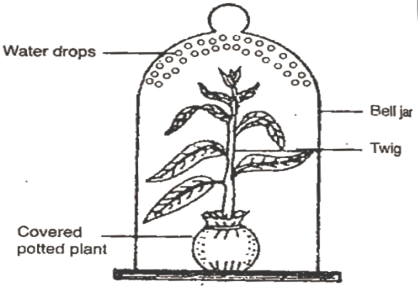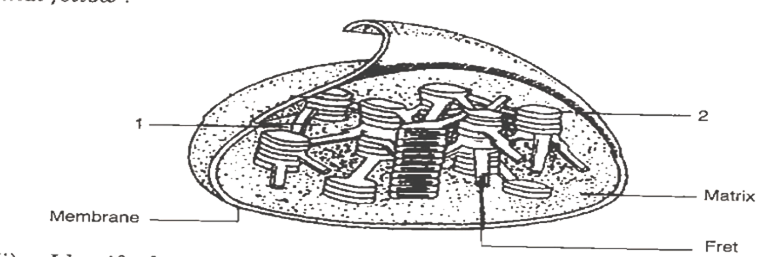 Short Answer Type
Short Answer TypeGiven below is an example of a particular structure and its special functional activity,
e.g. Glomerulus and ultrafiltration. On a similar pattern, complete the following:
(i) Corpus luteum and __ .
 Long Answer Type
Long Answer TypeGiven below is an experimental setup to study a particular process.
(1) Name the process being studied.
(ii) Explain the process named in (i) above.
(iii) Why Is the pot covered with a plastic sheet?
(iv) Mention one way in which this process is beneficial to the plant.
(v) Suggest a suitable control for this experiment.(i) Transpiration.
(ii) Transpiration is the process in which water in the form of water vapour is lost
from the aerial parts of the plant such as the leaves and soft stems of the plant. A small quantity of water absorbed by the roots is actually used by the plant body.
The rest of the water is lost through transpiration. Transpiration helps to cool the
plant. It also helps to regulate the temperature of the surrounding area.
(iii) The pot is covered to prevent the escape of water vapour from it and check for the process of transpiration.
(iv)Transpiration creates a suction force and thus helps in the ascent of sap in the plant. Increased transpiration results in more water and minerals being absorbed from the soil by the root hair cells.
(v) A suitable control for this experiment would be a pot without a plant covered with a plastic sheet and kept in the bell jar.
(a) Given below is a diagrammatic: representation of the internal structure of an organelle
found In a plant cell. Study the same and then answer the questions which follow.
(i) Identify the organelle.
(II) Name the physiological process occurring in this organelle.
(HI) Mention one way in which this process is beneficial to man.
(lv) Name the phases of the process occurring in the part labelled '1' and '2'.
(v) A chemical substance 'NADP' plays an active part In one of the phases. Give the expanded form of NADP and state its role In the above process.
(vi) Represent the physiological process mentioned In (ii) above in the form of a chemical equation.Draw a diagram of the human eye as seen in a vertical section and label the part which suits the following functions/descriptions:
(i) The layer which prevents the reflection of light.
(ii) The structure which alters the focal length of the lens.
(iii) The region of distinct vision.
(iv) The part which transmits the impulse to the brain.
(v) The outermost transparent layer in front of the eye lens.
(vi) The fluid present in the anterior part of the eye in front of the eye lens.Complete the following table by filling in the blanks 1 to 10 with the appropriate terms:
| Gland | Secretion | Function/Effect on Body |
| 1 Adrenal 5 Lachrymal 9 |
Testosterone 3 6 7 Growth hormone |
2 4 Influences metabolism of cell 8 10 |
Given below are diagrams showing different stages in the process of fertilization of an egg in the female reproductive tract.
(i) Use the letters given below each diagram to show the correct order in the process of fertilization.
(ii) Where in the female reproductive system does this process normally take place?
(iii) What is the biological term for the product of fusion?
(iv) What is the chromosome number of (1) the egg (2) the fused product?
(v) Draw a neat labelled diagram of a mature human sperm.
The diagram given below depicts the cross section of the spinal cord. Study the same and then answer the questions which follow:
(i) Name the process which is being depicted.
(ii) Name the parts labelled 2, 5 and 6.
(iii) Name the cells In contact with the part labelled '1'.
(iv)What is the function of the part labelled 3, 4 and 7? What is the technical term given to the pathway represented by 3, 4 and 7?
(v) How does the arrangement of cells In the spinal cord differ from that in the brain?
Given below are diagrams of plant cells as seen under the microscope after having
been placed in two different solutions.
(i) What is the technical term for the condition of
1. Cell A
2. Cell B.
(ii) From the solutions given in brackets (water, strong sugar solution, 1% salt
solution), name the solution into which 1. Cell A and 2. Cell B was placed before being viewed under the microscope.
(iii) Under what conditions in the soil will the root hair cell resemble 1. Cell A and
2. Cell B?
(iv) Name the pressure responsible for the movement of water from the root hair cell
to the xylem of the root. How is it set up?
(v) Name the pressure which helps in the movement of water up the xylem of the root.
